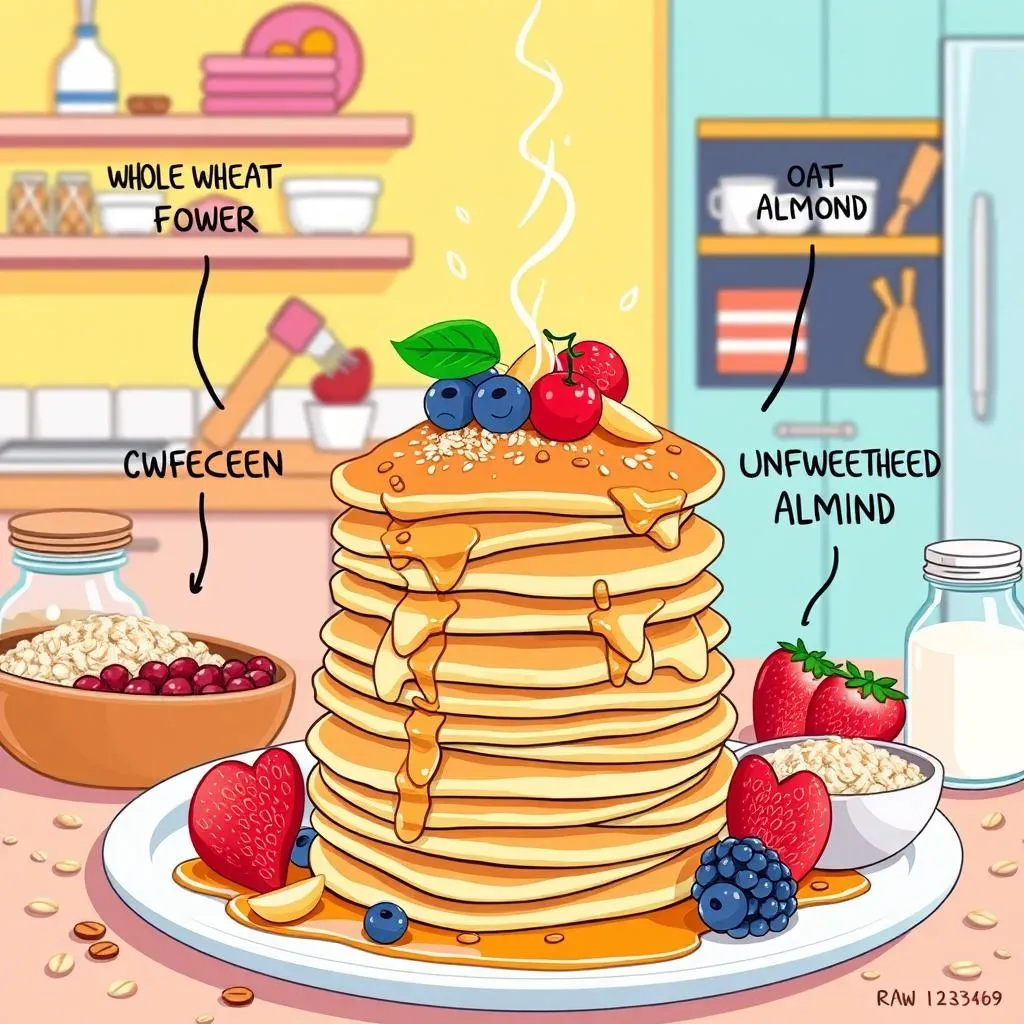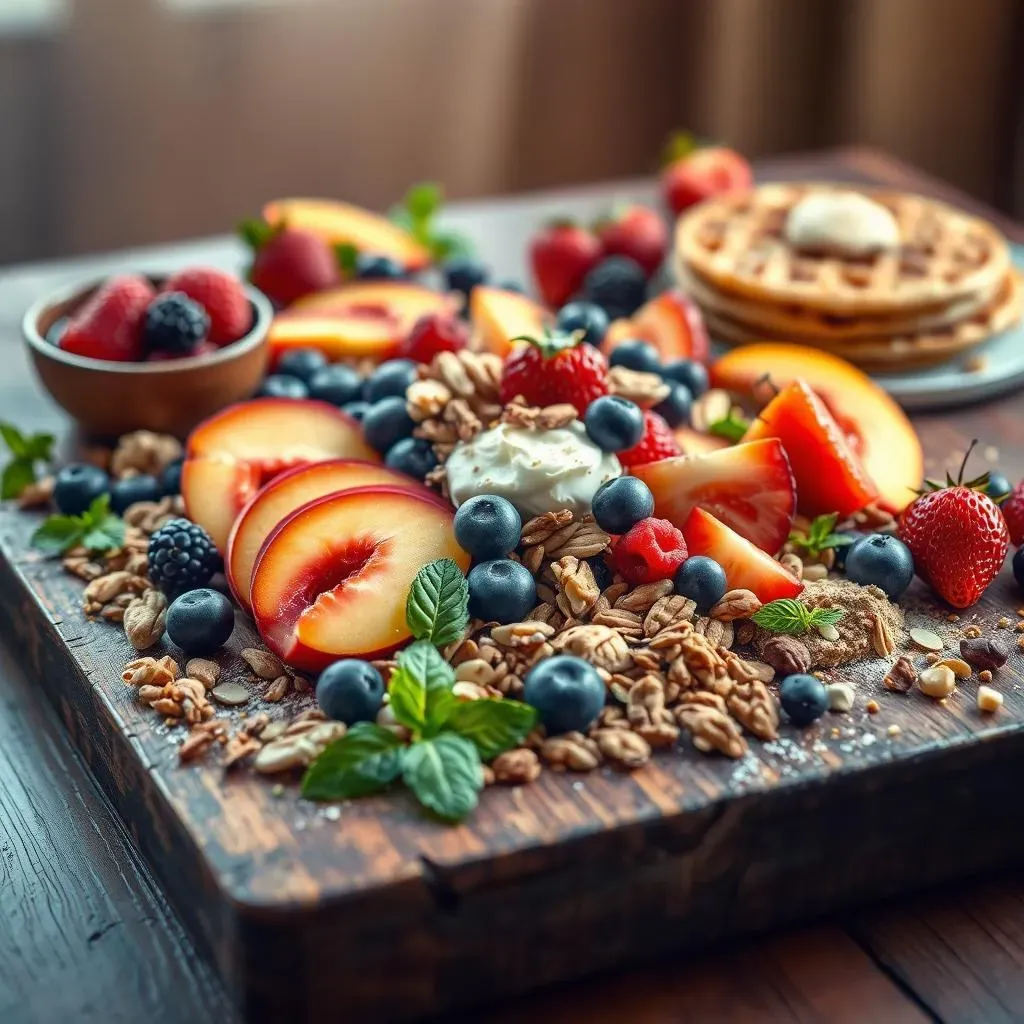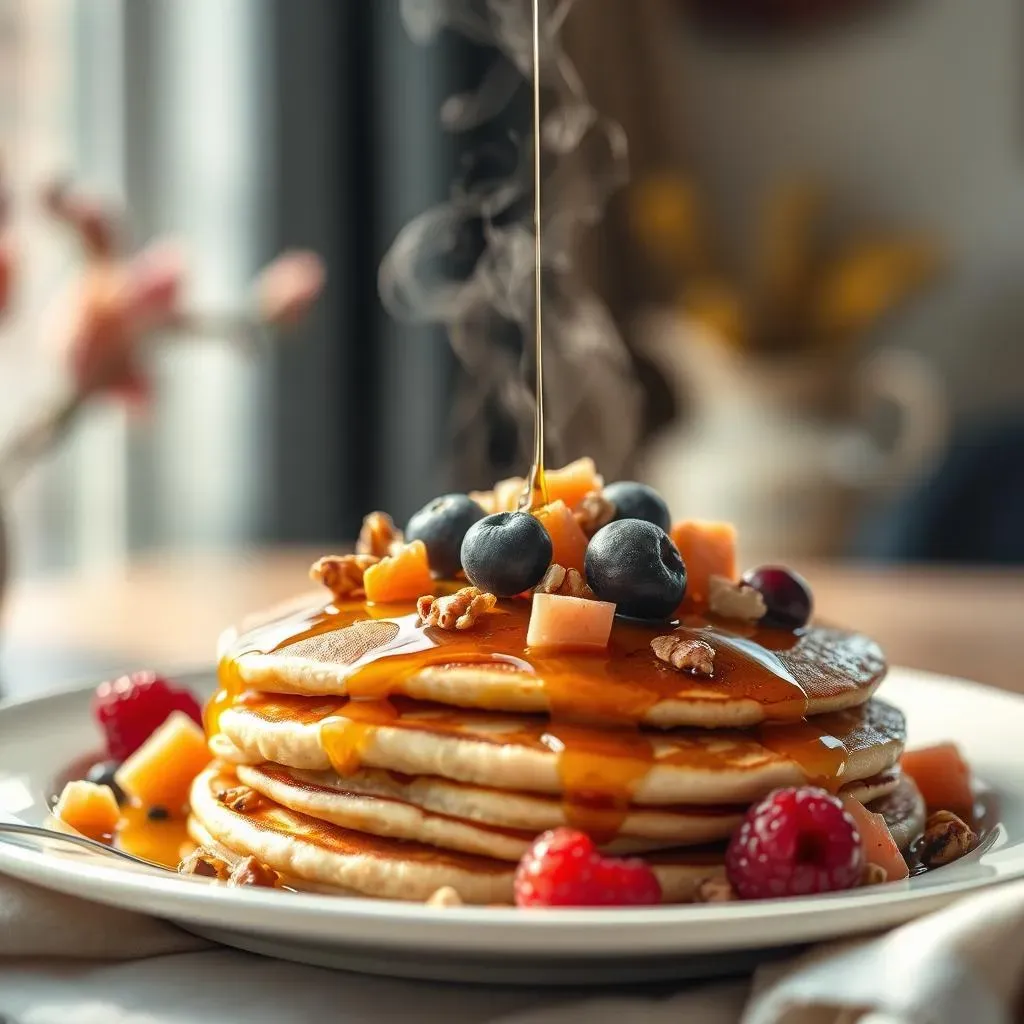Table of Contents
Let's be honest, pancakes are amazing. But the guilt after devouring a stack of fluffy, syrup-drenched discs? Not so amazing. That's where this guide comes in! We're diving headfirst into the world of "healthy pancake recipe low calorie," proving you don't have to sacrifice taste for health. Forget those dense, flavorless "diet" pancakes – we're talking light, fluffy, and surprisingly satisfying creations. This article will equip you with the knowledge to choose the best ingredients, perfect your batter, explore exciting topping options, and even master the art of pancake meal prepping. Get ready to discover a whole new world of healthy and delicious breakfast possibilities. We’ll explore smart ingredient choices, techniques for a perfect batter, creative topping ideas, and handy tips for storage and reheating. By the end, you'll be whipping up low-calorie pancakes that taste incredible and leave you feeling energized, not sluggish. So, grab your whisk, let's get started!
Ingredient Spotlight: Choosing the Healthiest Options

Ingredient Spotlight: Choosing the Healthiest Options
Flour Power: Whole Wheat vs. Alternatives
Picking the right flour is key to a healthy, low-calorie pancake. Whole wheat flour is your best friend here; it adds fiber and nutrients, keeping you fuller for longer. But don't worry if you're gluten-free! There are fantastic alternatives like almond flour (check out our almond flour pancake recipe) or oat flour, which can create equally delicious pancakes. Just be mindful that these alternatives might change the texture slightly.
Experimenting is half the fun! You might find you prefer the slightly nutty taste of almond flour or the hearty texture of oat flour. Don't be afraid to try different combinations. For example, you can make a blend of whole wheat and almond flour for a unique flavor and texture. Remember, the perfect pancake is a personal preference!
Flour Type | Pros | Cons |
|---|---|---|
Whole Wheat | High fiber, nutritious | Can be slightly denser |
Almond Flour | Gluten-free, nutty flavor | More expensive, can be dry |
Oat Flour | Gluten-free (if certified), hearty | Can be slightly gritty |
Sweeteners and Liquid Choices: Keeping it Light
Next up: sweeteners and liquids. Instead of relying on refined sugar, consider natural sweeteners like mashed banana (try our banana oat pancakes recipe!), applesauce, or a touch of maple syrup. These add sweetness without the calorie crash. For liquids, unsweetened almond milk or Greek yogurt are excellent choices. They provide moisture and a boost of protein, keeping your pancakes satisfying and preventing them from becoming too dry.
Remember, even seemingly small changes can make a big difference in the overall calorie count. For example, switching from regular milk to unsweetened almond milk can significantly reduce the sugar and calorie content of your pancakes. Similarly, using mashed banana instead of refined sugar not only reduces calories but also adds potassium and fiber to your breakfast. You can also find some great tips on avoiding common mistakes in our guide to avoiding common healthy pancake mistakes.
- Use mashed banana for natural sweetness.
- Opt for unsweetened almond milk or Greek yogurt.
- Experiment with different spices like cinnamon or nutmeg.
Mastering the Perfect LowCalorie Pancake Batter

Mastering the Perfect LowCalorie Pancake Batter
Okay, so you've got your healthy ingredients – now let's whip up some magic! The key to light and fluffy low-calorie pancakes lies in the technique. Don't just dump everything in a bowl and hope for the best! Start by whisking your dry ingredients (flour, baking powder, a pinch of salt – maybe some cinnamon if you’re feeling fancy!) together in a separate bowl. This prevents lumps and ensures even baking. Then, in another bowl, gently combine your wet ingredients (milk, egg whites – if using, and your chosen sweetener). The gentler you are, the fluffier your pancakes will be! Think of it like a delicate dance, not a wrestling match.
Next, gradually add your wet ingredients to the dry, mixing just until combined. Overmixing develops gluten, leading to tough pancakes. You want a slightly lumpy batter – that's your sign that you've done it just right. Trust me, a few lumps are your friends here! For extra fluffiness, let the batter rest for about 5-10 minutes before cooking. This allows the gluten to relax, resulting in those light and airy pancakes we all crave. Speaking of extra fluff, have you tried our fluffy healthy pancakes recipe? It's a game changer!
- Whisk dry ingredients separately.
- Gently combine wet ingredients.
- Mix wet and dry until just combined.
- Let the batter rest for 5-10 minutes.
Now, for the cooking process itself. Heat a lightly oiled griddle or non-stick pan over medium heat. Pour 1/4 cup of batter onto the hot surface for each pancake. Cook for 2-3 minutes per side, or until golden brown and cooked through. Don't overcrowd the pan; this will lower the temperature and result in soggy pancakes. Cook in batches if necessary. And remember, patience is a virtue, especially when it comes to achieving perfectly cooked pancakes. Want to learn more about cooking techniques? Check out our tips for making perfect healthy pancakes!
Once cooked, serve immediately and enjoy! Experiment with different cooking times to find what works best for your stovetop and desired level of doneness. A little experimentation can go a long way in perfecting your pancake-making skills. And don't forget the toppings! We've got some fantastic ideas coming up next. But first, here's a little table summarizing the process:
Step | Action | Important Note |
|---|---|---|
1 | Whisk dry ingredients | Prevent lumps |
2 | Combine wet ingredients | Gentle mixing is key |
3 | Combine wet and dry | Mix until just combined |
4 | Rest the batter | 5-10 minutes for fluffiness |
5 | Cook on medium heat | Don't overcrowd the pan |
Creative Toppings and Flavor Combinations

Creative Toppings and Flavor Combinations
Fruity Delights: Berries, Bananas, and Beyond
Let's talk toppings! Fresh berries are a classic choice. Blueberries, raspberries, and strawberries add a burst of sweetness and antioxidants. Mashed banana adds natural sweetness and moisture, as we discussed earlier. But don't stop there! Consider sliced peaches, mangoes, or even a sprinkle of pomegranate seeds for a beautiful pop of color and flavor. The possibilities are endless!
For a truly decadent experience, try adding a dollop of sugar-free yogurt or a drizzle of pure maple syrup. Just remember moderation is key; we're aiming for healthy, low-calorie pancakes, not a sugar rush. You can find some more ideas in our healthy pancake toppings guide. And if you are looking for a healthier option, try some cinnamon or nutmeg.
- Fresh berries (blueberries, raspberries, strawberries)
- Sliced peaches or mangoes
- Pomegranate seeds
- Sugar-free yogurt (in moderation)
- Pure maple syrup (a tiny drizzle)
Nutty and Seed-y Goodness: Adding Crunch and Flavor
Want to add some satisfying crunch? Nuts and seeds are your friends! A sprinkle of chopped walnuts, pecans, or almonds provides healthy fats and a delicious nutty flavor. Chia seeds or flax seeds are excellent choices too, adding fiber and omega-3 fatty acids. These additions not only boost the nutritional value but also enhance the texture, creating a delightful contrast to the soft pancakes.
Remember to chop your nuts and seeds finely before sprinkling them on top. This prevents large chunks that might make the pancakes difficult to eat. If you're feeling particularly adventurous, you could even create a homemade nut and seed topping by combining your favorite options with a touch of cinnamon and maple syrup. Check out our recipe using fruit for more inspiration.
Topping | Nutritional Benefit | Flavor Profile |
|---|---|---|
Walnuts | Healthy fats, antioxidants | Rich, earthy |
Chia Seeds | Fiber, omega-3s | Mild, slightly nutty |
Flax Seeds | Fiber, omega-3s | Mild, slightly earthy |
Spice it Up: Flavor Boosters for a Zesty Kick
Don't underestimate the power of spices! A dash of cinnamon adds warmth and sweetness, complementing the natural flavors of your pancakes perfectly. Nutmeg provides a more complex, slightly sweet and warm flavor. For a bolder kick, consider a pinch of cardamom or ginger. These spices not only add depth of flavor but also offer various health benefits.
Experiment with different spice combinations to create your signature pancake flavor. A blend of cinnamon and nutmeg is a classic pairing, while ginger and cardamom offer a more unique and exotic twist. Don’t be afraid to get creative! You can also incorporate spices directly into the batter for a more infused flavor. Looking for more inspiration? Check out our sugar-free pancake recipe for some exciting ideas!
Storage, Reheating, and Meal Prep Tips for Busy Mornings

Storage, Reheating, and Meal Prep Tips for Busy Mornings
Smart Storage Solutions: Keeping Your Pancakes Fresh
Let's face it, mornings can be hectic. Having healthy, delicious pancakes ready to go makes a huge difference. Proper storage is key to keeping your pancakes fresh and flavorful. Once cooled completely, store leftover pancakes in an airtight container in the refrigerator. They'll stay good for up to 3-4 days. For longer storage, consider freezing them. Wrap individual pancakes tightly in plastic wrap, then place them in a freezer-safe bag. Frozen pancakes can last for up to 2 months. This is a lifesaver for busy week mornings!
Freezing individual pancakes allows you to grab just what you need without thawing the whole batch. It's perfect for those mornings when you're short on time but still want a healthy, home-cooked breakfast. Need a refresher on the best practices for storing your pancakes? Check out our ultimate guide to storing healthy pancakes for more detailed instructions and tips.
- Refrigerate in an airtight container (up to 3-4 days)
- Freeze individually wrapped pancakes (up to 2 months)
- Label and date your containers for easy organization
Reheating and Meal Prep Magic: Pancakes on Demand
Reheating your stored pancakes is a breeze! For refrigerated pancakes, simply heat them in a non-stick pan over medium heat for a minute or two per side, until warmed through. You can also microwave them for 30-60 seconds, but be careful not to overcook them, as they might become dry. For frozen pancakes, let them thaw overnight in the refrigerator before reheating. This ensures even heating and prevents soggy pancakes. Want to make reheating even easier? Try reheating them in a toaster oven!
Meal prepping is a game-changer for busy schedules. Make a big batch of pancakes on the weekend, store them properly, and you'll have a healthy and delicious breakfast ready to go all week long. You can even prep your toppings ahead of time – chop your fruits and nuts, and store them separately in airtight containers. This will save you valuable time in the mornings and help you stick to your healthy eating goals. To help with your meal prep, check out our healthy pancake recipe for breakfast!
Reheating Method | Pros | Cons |
|---|---|---|
Non-stick pan | Even heating, maintains texture | Requires more time |
Microwave | Quick and easy | Can become dry if overcooked |
Toaster Oven | Crisp edges, even heating | May not be suitable for all types of pancakes |